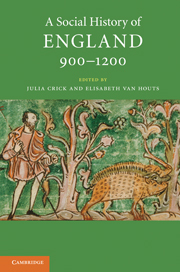Book contents
- Frontmatter
- Contents
- List of figures
- List of maps and tables
- List of contributors
- Acknowledgements
- List of abbreviations
- Map 1 England and its neighbours
- Map 2 England 900–1200
- I Introduction
- I.1 Land use and people
- I.2 Water and land
- I.3 Forest and upland
- I.4 Mineral resources
- I.5 Health and disease
- II.1 Authority and community
- II.2 Lordship and labour
- II.3 Order and justice
- II.4 War and violence
- II.5 Family, marriage, kinship
- II.6 Poor and powerless
- III.1 Towns and their hinterlands
- III.2 Commerce and markets
- III.3 Urban planning
- III.4 Urban populations and associations
- IV.1 Invasion and migration
- IV.2 Ethnicity and acculturation
- IV.3 Intermarriage
- IV.4 The Jews
- V.1 Religion and belief
- V.2 Rites of passage and pastoral care
- V.3 Saints and cults
- V.4 Public spectacle
- V.5 Textual communities (Latin)
- V.6 Textual communities (vernacular)
- VI.1 Learning and training
- VI.2 Information and its retrieval
- VI.3 Esoteric knowledge
- VI.4 Medical practice and theory
- VI.5 Subversion
- Glossary
- Time line 900–1200
- Further reading
- Index
IV.2 - Ethnicity and acculturation
Published online by Cambridge University Press: 05 June 2012
- Frontmatter
- Contents
- List of figures
- List of maps and tables
- List of contributors
- Acknowledgements
- List of abbreviations
- Map 1 England and its neighbours
- Map 2 England 900–1200
- I Introduction
- I.1 Land use and people
- I.2 Water and land
- I.3 Forest and upland
- I.4 Mineral resources
- I.5 Health and disease
- II.1 Authority and community
- II.2 Lordship and labour
- II.3 Order and justice
- II.4 War and violence
- II.5 Family, marriage, kinship
- II.6 Poor and powerless
- III.1 Towns and their hinterlands
- III.2 Commerce and markets
- III.3 Urban planning
- III.4 Urban populations and associations
- IV.1 Invasion and migration
- IV.2 Ethnicity and acculturation
- IV.3 Intermarriage
- IV.4 The Jews
- V.1 Religion and belief
- V.2 Rites of passage and pastoral care
- V.3 Saints and cults
- V.4 Public spectacle
- V.5 Textual communities (Latin)
- V.6 Textual communities (vernacular)
- VI.1 Learning and training
- VI.2 Information and its retrieval
- VI.3 Esoteric knowledge
- VI.4 Medical practice and theory
- VI.5 Subversion
- Glossary
- Time line 900–1200
- Further reading
- Index
Summary
Over the last twenty years the constructed nature of ethnic identity has been extensively discussed, and both historians and archaeologists have explored the processes – often dubbed ‘ethnogenesis’ – by which ethnic groups came into existence, were transformed and, in some cases, disappeared. This branch of scholarship has mainly focused on the societies of the early post-Roman centuries, but studies of later periods have more recently begun to address similar issues. Drawing on both historical and archaeological evidence, this subchapter explores the construction of ethnic identity and the processes of acculturation in England in the wake of successive invasions and migrations during the period c. 900–1200. Despite the presence of various migrant groups, who were frequently in the political ascendancy and in some regions were also numerically dominant, a sense of Englishness prevailed, both politically and culturally.
For much of the twentieth century researchers of the early medieval period regarded ethnic identity as largely unproblematic, and as readily identifiable from the ascription of ethnic labels to individuals and groups in contemporary sources and from discrete distributions of material culture. Such attitudes have, however, been thrown into sharp relief by scholarly developments since the 1980s. Patrick Geary memorably described ethnic identity as ‘a situational construct’, liable to be modified according to circumstances, and he argued that ‘early medieval ethnicity should be viewed as a subjective process by which individuals and groups identified themselves or others within specific situations and for specific purposes’.
- Type
- Chapter
- Information
- A Social History of England, 900–1200 , pp. 235 - 246Publisher: Cambridge University PressPrint publication year: 2011
- 2
- Cited by

